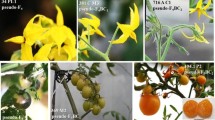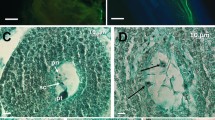Abstract
A new tomato rootstock seed parent which combines the characters green stem, potato leaf and long style in a Lycopersicon esculentum genotype has been produced. This will facilitate seed production of the interspecific F1 hybrid rootstock which is used for grafted crops, and also permit the positive identification of any off-types which arise from accidental self-pollination of the seed parent. The new seed parent has been named GCR 66. It is proposed that rootstocks derived from this type of seed parent shall be called ‘Markerstocks’. GCR 66 is very similar to the cultivar ‘Ailsa Craig’ in its agronomic characters and will be useful for studies with the tomato when pollination needs to be accurately controlled.
Similar content being viewed by others
References
Bishop, C. J., 1954. A stamenless male sterile tomato. Amer. J. Bot. 41, 540–542.
Bravenboer, L., 1957. Nieuwe mogelijkheden voor het enten van groentegewassen onder glas. Meded. Dir. Tuinb. 20, 707–713.
Bravenboer, L. and Pet, G., 1963. Control of soil-borne diseases in tomatoes by grafting on resistant rootstocks. XVI. Int. hort. Congr. 1962 (Proceedings). II, 317–324.
Currence, T. M., 1944. A combination of semi-sterility with two simply inherited characters that can be used to reduce the cost of hybrid tomato seed. Proc. Am. Soc. hort. Sci. 44, 403–406.
Darby, L. A., 1956. Tomato breeding. N.A.A.S. Quarterly Review 31, 1–9.
Honma, S., and Currence, T. M., 1954. Combining ability of five tomato backcross selections compared with that of the parents. Proc. Am. Soc. hort. Sci. 63, 431–439.
Last, F. T., and Ebben, M. H., 1966. The epidemiology of tomato brown root rot. Ann. appl. Biol. 57, 95–112.
Lewis, D., 1955. Rep. John Innes hort. Inst., 1954, 12.
Nickeson, R. L., 1957. Selection for combining ability in a male sterile tomato line having two recessive seedling genes. Diss. Abstr. 17, 1876.
Nickeson, R. L. and Currence, T. M., 1958. Selecting for combining ability in a male-sterile tomato line having two recessive seedling genes. Proc. Am. Soc. hort. Sci. 72, 377–384.
Rick, C. M., Baughn, C. G., and Hall, B. J., 1956. Three new hybrid tomatoes. Calif. Agric. 10, no. 1: 4–5, 10.
Smith, J. W. M., 1965. Rep. Glasshouse Crops Res. Inst., 1964, 53.
Smith, J. W. Maxon, and Proctor, P., 1965. Use of disease resistant rootstocks for tomato crops. Expl. Hort. 12, 6–20.
Szteyn, K., 1962. Interspecific crosses in the genus Lycopersicum L. I. Backcrosses to Lycopersicum glandulosum. Euphytica 11, 149–156.
Termohlen, G. P., 1962. Onderzoekingen over kurkwortel van tomaat en over de kurkwortelschimmel. Thesis Wageningen, Veenman & Zonen, 1962; Tijdschrift over Planteziekten 68, 295–367.
Williams, W., 1961. Rep. John Innes Inst., 1960, 7.
Author information
Authors and Affiliations
Rights and permissions
About this article
Cite this article
Smith, J.W.M. A new tomato rootstock seed parent. Euphytica 15, 395–403 (1966). https://doi.org/10.1007/BF00022186
Received:
Issue Date:
DOI: https://doi.org/10.1007/BF00022186




